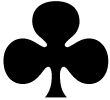|
|  J 9 J 9 |
|
|
 J 9 8 J 9 8 |
|
|
 A K 10 4 A K 10 4 |
|
|
 Q J 7 3 Q J 7 3 |
|
 10 7 4 10 7 4 |
|
 K Q 5 K Q 5 |
 6 4 3 2 6 4 3 2 |
|
 K 7 K 7 |
 Q 8 6 2 Q 8 6 2 |
|
 7 5 3 7 5 3 |
 K 10 K 10 |
|
 9 8 6 5 4 9 8 6 5 4 |
|
 A 8 6 3 2 A 8 6 3 2 |
|
|
 A Q 10 5 A Q 10 5 |
|
|
 J 9 J 9 |
|
|
 A 2 A 2 |
Contract: 3 no |
The hand combines a rather interesting covering situation, along with what I call a communication suit. I'll get to that in a moment. Opening lead was West's 4th highest heart, East going up, his king being taken by declarer's ace. Declarer then proceeded to run three more heart tricks, sluffing a club. He then led a low spade, which seems to balance a long-card potential, which we can see is there, against losing too many tricks in the suit on a 4-2 split (and which wouldn't have been my first choice). East took the spade trick with the K and shifted to a club, ducked to the king, and now won a spade lead! He was so close to establishing that spade suit and thereby losing the only three tricks he has to lose. Now, however, he abandoned spades, neglected to unblock the ace of clubs, eschewed a diamond hook, and wound up with 8 winners instead of 10 for a richly deserved 4% board.
First the communication suit. I don't know how many times I've seen novices -- it's the only word I can use, however they describe themselves -- run their best suit before asking how they're going to get the tricks they need or in any event can drum up. I call it a communication suit because it quite often represents communication back and forth between the two hands that will be sorely needed later -- as is the case here -- and far more often than not, does not represent an embarrassment to the opposition in terms of finding discards. West has as many hearts as declarer, and East has some worthless clubs he can discard without harm.
Here the communication is needed because of an interesting covering situation in diamonds. When the heart suit is cleared from the table, West can now hold declarer to three diamond tricks if he covers astutely, which means: cover the jack if that is led first. The suit blocks, holding declarer to 3 tricks in it. Cover the 9 if that is led first, or don't cover either the 9 or J. The suit blocks, holding declarer to 3 winners in it. If you fail to cover the jack if that is led first, you're out of luck. All this would be meaningless, of course, if declarer had saved his hearts and the luck handed to him on that opening lead. Declarer would have 4 diamond winners whatever West did.
"Wait a minute, now, wise guy! I'm going to recover. I'm going to play my jack of diamonds, see it get covered, come to my nine of diamonds, play the ace of clubs and a low club (which this declarer couldn't do after ducking a club lead). West gets out with a spade, which East wins, continuing the suit, which I win, and then lose a spade to East who now must let me have all the diamond and club winners I can handle. I get 4 hearts, 4 diamonds, 2 clubs and a spade, except that that adds up to 11 and the defense has 3 tricks. So I'll have a redundant winner somewhere along the line."
Hm-m-mmm. By golly, it looks as though that would work. But it sure does look a lot riskier than simply holding off the hearts until you'd established the diamonds. Indeed, if declarer would hit diamonds right away, where he doesn't have to lose the lead, and then clubs, it's hard to see why he wouldn't have 11 winners -- or twelve.
Anyway, my primary interest lies in the intriguing covering situation induced by declarer's running the hearts, i.e., depriving himself of an entry outside of diamonds. Note that if West fails to cover the J (first round), declarer now has an easy path to 4 diamond winners. But if declarer fails to cover the 9, first round, another duck puts declarer with the J opposite A K 10, meaning he has to overtake for 3 diamond winners. But covering either card first round blocks the suit and holds declarer to 3 winners. Note also how important a "mere" 8 becomes.